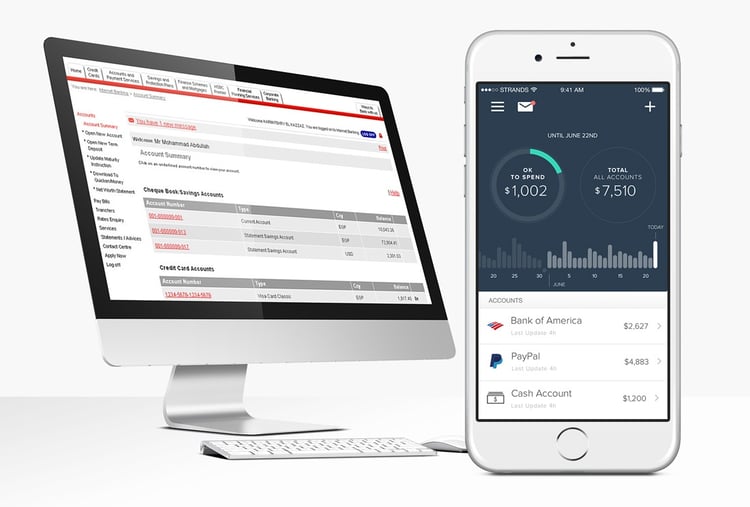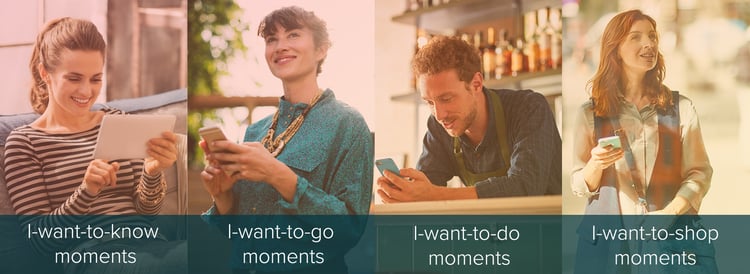Dear Banker, We Need to Talk About UX

- Vaida Pakulyte, Digital Marketing Manager at Strands
- 24.05.2017 10:00 am Digital transformation , user experience , digital banking , design for finance , personalized finance
Design has changed (and even transformed) a lot of industries: music, technology, electronics, fashion. And not surprisingly, the financial industry is not immune to their impact.
The reality is that more agile and digital-only banks like N26, Moven and Simple, are fundamentally changing the relationship people have with banks. Digital only-banks have reshaped what used to be a simple transactional relationship and if big banks want to follow suit, user experience is where they need to excel. Given rapidly evolving needs and consumer behavior, banks should start creating humanized digital experiences today's consumers expect.
If you compare typical banking dashboards with FinTech design from MoneyStrands, which would you use?

Humanize online banking
According to the scientists, 80% of consumer behavior is determined by the part of the human brain referred to as our subconscious. Managing finances is an artificial concept and people are not naturally adept at controlling their financial behavior, they also do not understand complex banking offers and services. Despite their best intentions, humans still fail to act in their best interest when it comes managing money online. On the other hand, why does it take only a few seconds to send a message on Facebook, but transferring money in a bank can take days?
By humanizing online banking, financial institutions can influence our behavior. For example, we are used to boring transactional statements, but many banks are bringing transactions alive by integrating other services. An example of bringing things to life is the Moven App, which alerts the user when they are spending and going over their budget limit by breaking the glass on their phone.
As Alex Kreger says, financial psychology will be in demand, meaning that firstly banks will need to understand financial cognition on a deeper level to architect services people demand.
Guide your users through financial milestones
Every person goes through certain important financial milestones in their life, for example, playing for higher education, buying a house, purchasing holiday tickets, investing, creating retirement funds, etc. Unfortunately, for banks many of these milestones are simple transactions controlled by online-payment specialists and digital merchants. In fact, the average consumer´s trust level in banks is about 40% compared with 70% trust level in technology companies, because it actually gives value to the user. Just think about Facebook timeline or Twitter news feed. Could our transactional history look this way, showing “friends’” opinions about financial services, contextual tips, social-based recommendations and personalized offers based on our financial life?
Ultimately, people's financial lives involve their family, friends and and feeling that a bank knows us, look out for us and reward with great solutions in real time is what matters.
Empower micro-interactions
Just like life is not an accumulation of years, days and hours, online banking is made up of thousands of tiny sub-actions and details that keep a customer engaged and guide them through their financial life.

In these moments consumers want what they want, when they want it - and they are drawn to brand that deliver on their needs
Banks have to map users’ journeys based on all these moments and deliver on their needs in a frictionless flow - showing money movement in an intuitive way, giving control to the consumer, not the bank itself. Plus, an instant understanding of their financial life and access to all type of accounts will be crucial in the future - giving actual financial wealth in a single all-encompassing dashboard - credit accounts, investment accounts and any relationships with other providers, enabling users to easily monitor and manage their financial “fitness”. As stated by Financial Brand, the bank UX will be transformed into a personal digital concierge that could ensure maximum satisfaction.
Move away from product-centric to user-centric design
Financial institutions have always focused on the performance of their products and services, but the rules of the game have changed. Today´s consumer is empowered. Empowered to choose online banking according to their needs, switch to another bank if they want to or choose a digital-only solution.
When banks place the customer (user) at the core of everything, they start understanding how access to financial services can add value to the daily lives of customers and make it fun too. Online banking does not have to be boring. Well-tailored and gamified financial services can help customers meet daily needs, achieve personal and business goals and lastly - relax, because their bank is taking care of their needs.
Creating a great user experience in online banking is an investment
Giving something extra to your customers isn't an expense. It is an absolute must, and the banking industry is no exception. It’s time to stop relying on old-school interfaces and pie-charts. Banks need to have a UX strategy and commit to it seriously. To put it simply, for a successful customers experience, bank needs to define strategy, build user-centred methodology of working and ingrain all business and development processes together - it can’t be a one-shot deal.
This article originally appeared on blog.strands.com





















